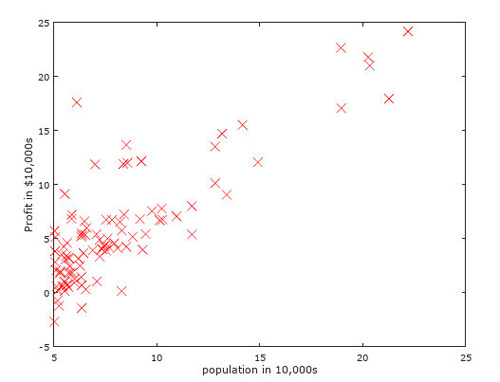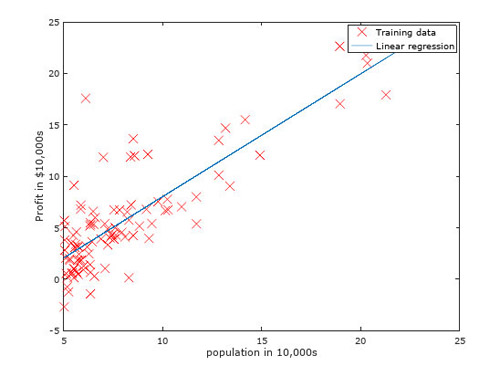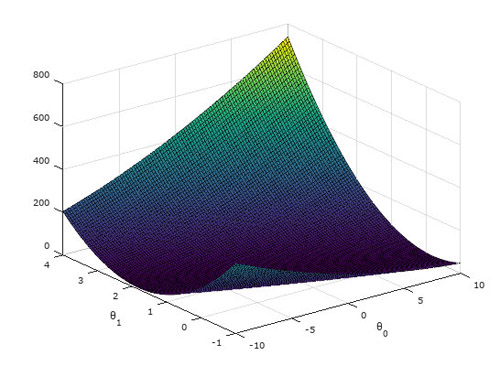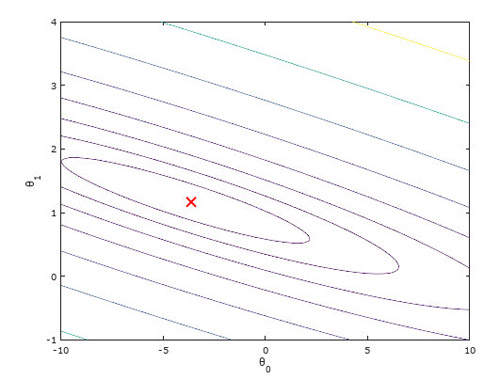一元線性回歸梯度下降算法的Octave仿真
在梯度下降算法理論篇中,曾經感嘆推導過程如此蒼白,如此期待仿真來給我更加直觀的感覺。當我昨晚Octave仿真后,那種成就感著實難以抑制。分享一下仿真的過程和結果,并且將上篇中未理解透澈的內容補上。
在Gradient Descent Algorithm中,我們利用不斷推導得到兩個對此算法非常重要的公式,一個是J(θ)的求解公式,另一個是θ的求解公式:
我們在仿真中,直接使用這兩個公式,來繪制J(θ)的分布曲面,以及θ的求解路徑。
命題為:我們為一家連鎖餐飲企業新店開張的選址進行利潤估算,手中掌握了該連鎖集團所轄店鋪當地人口數據,及利潤金額,需要使用線性回歸算法來建立人口與利潤的關系,進而為新店進行利潤估算,以評估店鋪運營前景。
首先我們將該企業的數據繪制在坐標圖上,如下圖所示,我們需要建立的模型是一條直線,能夠在最佳程度上,擬合population與profit之間的關系。其模型為:
在逼近θ的過程中,我們如下實現梯度下降:進行了1500次的迭代(相當于朝著最佳擬合點行走1500步),我們在1500步后,得到θ=[-3.630291,1.166362];在3000次迭代后,其值為[-3.878051,1.191253];而如果運行10萬次,其值為[-3.895781,1.193034]。可見,最初的步子走的是非常大的,而后,由于距離最佳擬合點越來越近,梯度越來越小,所以步子也會越來越小。為了節約運算時間,1500步是一個完全夠用的迭代次數。之后,我們繪制出擬合好的曲線,可以看得出,擬合程度還是不錯的。
下圖是J(θ)的分布曲面:
接來下是我們求得的最佳θ值在等高線圖上所在的位置,和上一張圖其實可以重合在一起:
關鍵代碼如下:
1、計算j(theta)
- function J = computeCost(X, y, theta)
- %COMPUTECOST Compute cost for linear regression
- % J = COMPUTECOST(X, y, theta) computes the cost of using theta as the
- % parameter for linear regression to fit the data points in X and y
- % Initialize some useful values
- m = length(y); % number of training examples
- % You need to return the following variables correctly
- J = 0;
- % ====================== YOUR CODE HERE ======================
- % Instructions: Compute the cost of a particular choice of theta
- % You should set J to the cost.
- h = X*theta;
- e = h-y;
- J = e'*e/(2*m)
- % =========================================================================
- end
2、梯度下降算法:
- function [theta, J_history] = gradientDescent(X, y, theta, alpha, num_iters)
- %GRADIENTDESCENT Performs gradient descent to learn theta
- % theta = GRADIENTDESENT(X, y, theta, alpha, num_iters) updates theta by
- % taking num_iters gradient steps with learning rate alpha
- % Initialize some useful values
- m = length(y); % number of training examples
- J_history = zeros(num_iters, 1);
- for iter = 1:num_iters
- % ====================== YOUR CODE HERE ======================
- % Instructions: Perform a single gradient step on the parameter vector
- % theta.
- %
- % Hint: While debugging, it can be useful to print out the values
- % of the cost function (computeCost) and gradient here.
- %
- h=X*theta;
- e=h-y;
- theta = theta-alpha*(X'*e)/m;
- % ============================================================
- % Save the cost J in every iteration
- J_history(iter) = computeCost(X, y, theta);
- end
- end








































